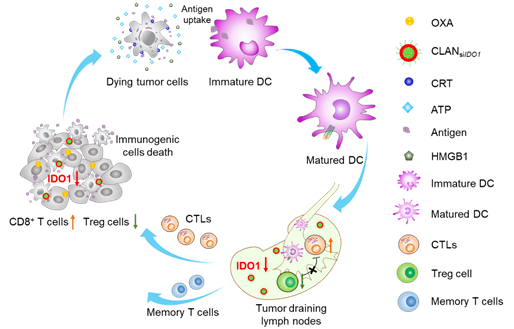Recently, A research paper “Nano-enabled Reversal of IDO1-mediated Immunosuppression Synergizes with Immunogenic Chemotherapy for Improved Cancer Therapy” published in Nano Letters. This study uses nanotechnology to reverse the IDO1-mediated tumor immunosuppression microenvironment and synergize the immunogenic chemotherapy drug oxaliplatin (OXA) to enhance the antitumor effect.
Certain chemotherapeutics (e.g., oxaliplatin, OXA) can evoke effective anti-tumor immunity responses by inducing immunogenic cell death (ICD). Unfortunately, tumors always develop multiple immunosuppressive mechanisms, such as the upregulation of immunosuppressive factors, to counteract the effects of immunogenic chemotherapy. Indoleamine 2,3-dioxygenase-1 (IDO1), a tryptophan catabolic enzyme overexpressed in tumor-draining lymph nodes (TDLNs) and tumor tissues, plays a pivotal role in the generation of the immunosuppressive microenvironment. Reversing IDO1-mediated immunosuppression may strengthen the ICD-induced immune response. Herein, we developed a nano-enabled approach for IDO1 pathway interference, which is accomplished by delivering IDO1 siRNA to both TDLNs and tumor tissues with the help of cationic lipid-assisted nanoparticles (CLANs). We demonstrated that the contemporaneous administration of OXA and CLANsiIDO1 could achieve synergetic anti-tumor effects via promoting dendritic cell maturation, increasing tumor-infiltrating T lymphocytes and decreasing the number of regulatory T cells in a subcutaneous colorectal tumor model. We further proved that this therapeutic strategy is applicable for the treatment of orthotopic pancreatic tumors and offers a strong immunological memory effect, which can provide protection against tumor rechallenge.

The first author of the thesis is Huang Hua, a PhD candidate and the corresponding authors are Professor Wang Jun, Professor Cao Jie and Dr. Shen Song. This research was supported by projects such as the National Key R & D Program, the National Natural Science Foundation of China, and the Guangdong Pearl River Talent Program Innovation Team.
Paper link: https://doi.org/10.1021/acs.nanolett.9b01807
